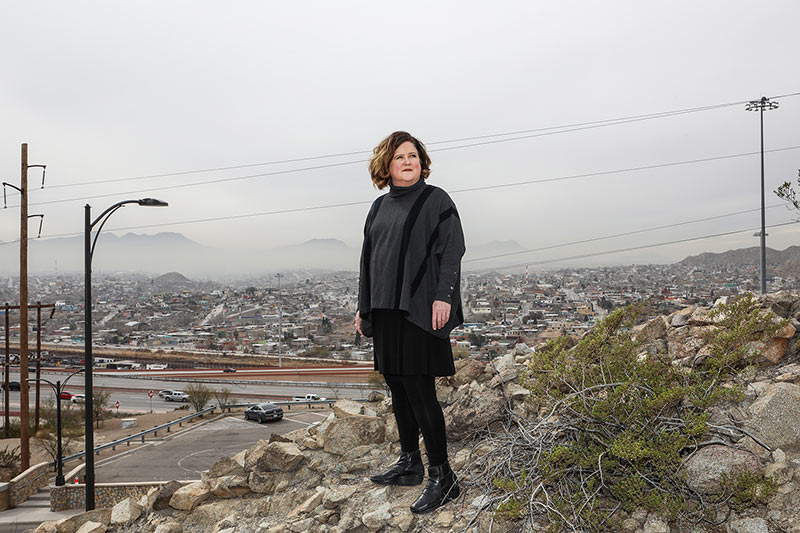UTEP's Rubin Center Earns Warhol Foundation Grant
Last Updated on January 29, 2020 at 12:00 AM
Originally published January 29, 2020
By Daniel Perez
UTEP Communications
Officials with The Andy Warhol Foundation for the Visual Arts announced Jan. 16, 2020, that it awarded $100,000 to The University of Texas at El Paso's Stanlee and Gerald Rubin Center for the Visual Arts to assist with future programs and exhibitions.

“This is an important grant because of the caliber of peer organizations that receive this award and the prestige of the foundation itself, which recognizes best practices in contemporary art,” said Kerry Doyle, director of the Rubin Center.
Doyle, who has been with the center since 2007 and became its director six years later, said the two-year grant will allow the center to host visiting artists for longer periods and to hire more local consultants.
“This grant is a vote of confidence about our trajectory as a visual arts institution,” said Doyle, who added that it puts the Rubin Center on par with such venues as the Arizona State University Art Museum, the University of California, Los Angeles Hammer Museum and the PS1 Contemporary Art Center in New York.
In accordance with Andy Warhol’s will, the mission of The Andy Warhol Foundation for the Visual Arts is the advancement of the visual arts. The foundation manages an innovative and flexible grants program while also preserving Warhol’s legacy through creative and responsible licensing policies and extensive scholarly research for ongoing catalogue raisonné projects. To date, the foundation has given more than $200 million in cash grants to more than 1,000 arts organizations in 49 states and abroad and has donated 52,786 works of art to 322 institutions worldwide.
“The Stanlee and Gerald Rubin Center is a vital platform for experimental artistic practice in the Southwest and internationally,” said Rachel Bers, the foundation’s program director. “We are thrilled to support the organization in its efforts to center the voices and visions of artists in cultural conversations that take place in, around and about border regions.”
This is the Rubin Center’s third Warhol Foundation grant. The New York-based foundation awarded the center $60,000 in 2005 and $100,000 in 2013. In addition to the funds, the foundation also has donated original prints and Polaroid photographs from the Warhol collection.
“The foundation is interested in building relationships with the organizations they fund, and we value this relationship,” Doyle said.
The Rubin director, who wrote the 2013 and the 2020 grant applications, said the foundation’s funds would help pay for programs and exhibitions over the next two years to include the fall 2020 “Border Crossers” exhibit created by visiting artist Chico MacMurtrie.
“Border Crossers,” as envisioned by MacMurtrie, is a series of inflatable robotic sculptures that he will set up on both sides of the U.S.-Mexico border in the El Paso-Juárez area. Each sculpture, which will stand several stories tall, will extend a trunk-like appendage to the other side of the border.
“Three years into developing my most complex and challenging art project to date, the “Border Crossers”, I met the ideal producer in Kerry Doyle,” MacMurtrie said. “Working with the Rubin Center has been an amazing experience preparing and shaping this complex project that revolves around community technology and the border.”
The piece is a perfect example of a STEAM (Science, Technology, Engineering, Art and Mathematics) project, said UTEP’s Angel Cabrales, assistant professor of art. He and 10 of his sculpture students will venture this summer to Bisbee, Arizona, which is about 320 miles west of El Paso, to assist MacMurtrie with this assignment.
Cabrales was grateful for the opportunity for his students to work with MacMurtrie and that the Warhol grant helped the Rubin Center to collaborate with the artist who was born in Deming, New Mexico, and grew up in the border town of Naco, Arizona.
“Networking is everything in the arts,” he said.
While the UTEP team does not know the scope of their duties in Arizona yet, Cabrales said it should expose them to the creative process on a professional scale that includes the need to solve problems while on a deadline. He added that the project’s use of technology should broaden the students’ perspectives.
“It will take art out of their subconscious and into a reality that includes science, physics and engineering,” he said. “I hope they’re inspired.”
Doyle added that the center would use the grant to support visiting artists and to build meaningful artistic relationships among students, faculty and alumni, as well as with other institutions of higher education such as the Autonomous University of Ciudad Juárez.
Rubin officials added that the grant would assist with other exhibits to include “Enola’s Head” by Japanese artist Gaku Tsutaja in spring 2021, and the “consonance/dissidence” exhibit that will feature the work of renowned Mexican artist Minerva Cuevas in fall 2021.